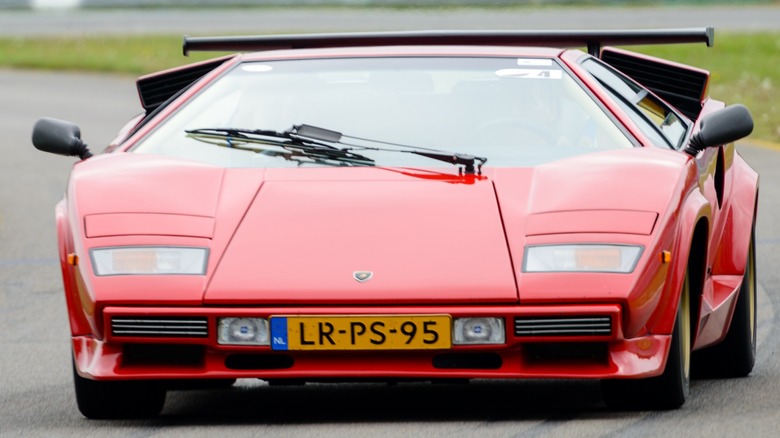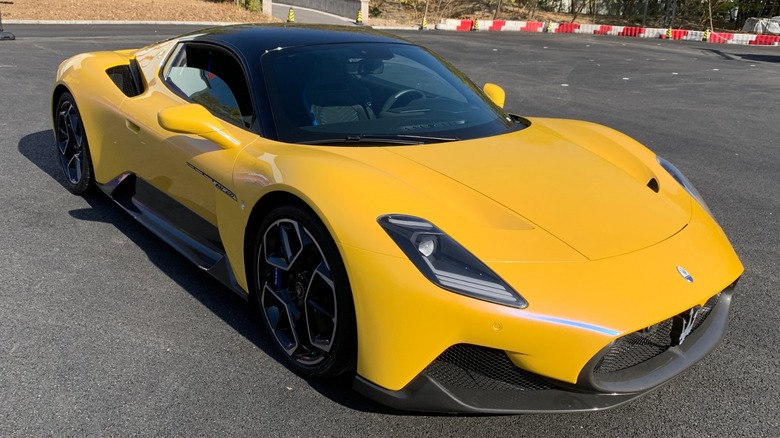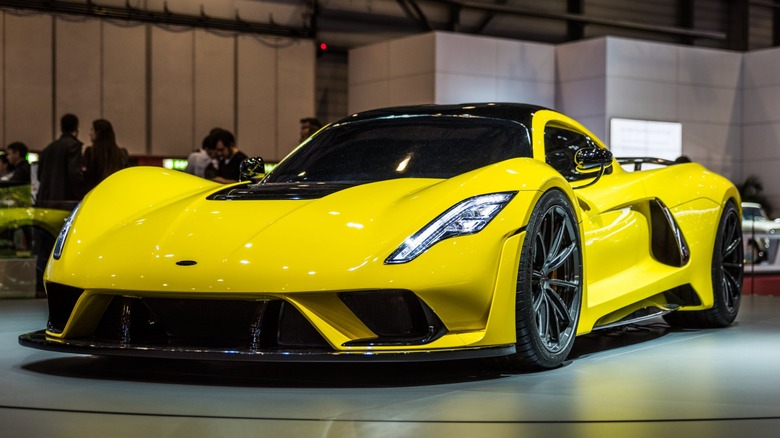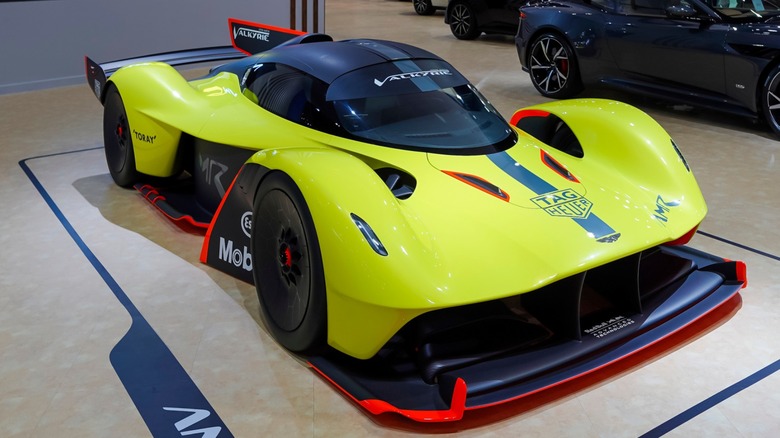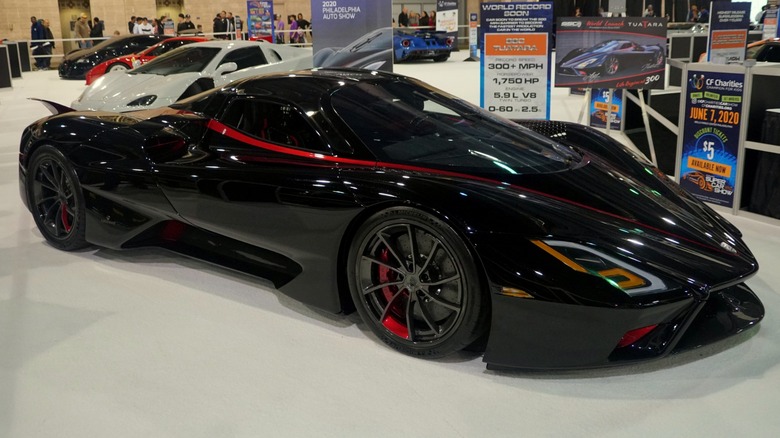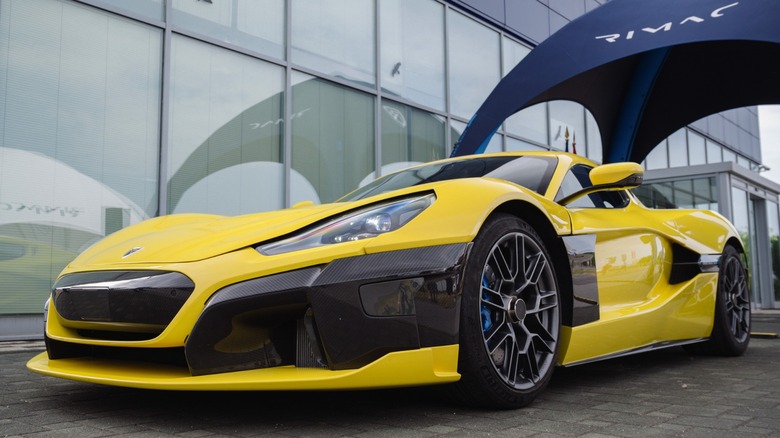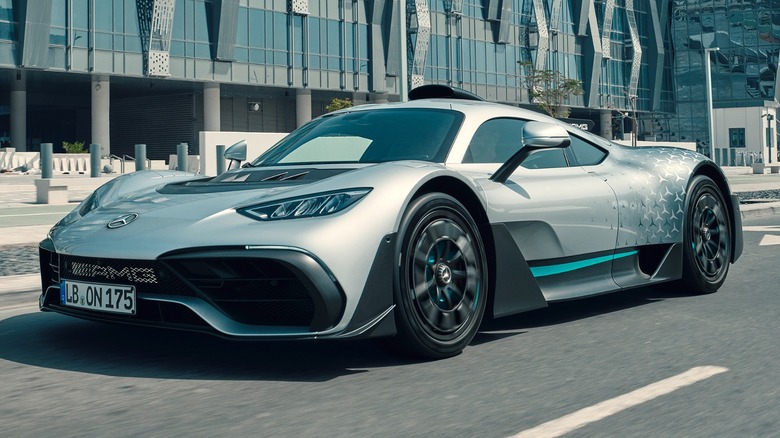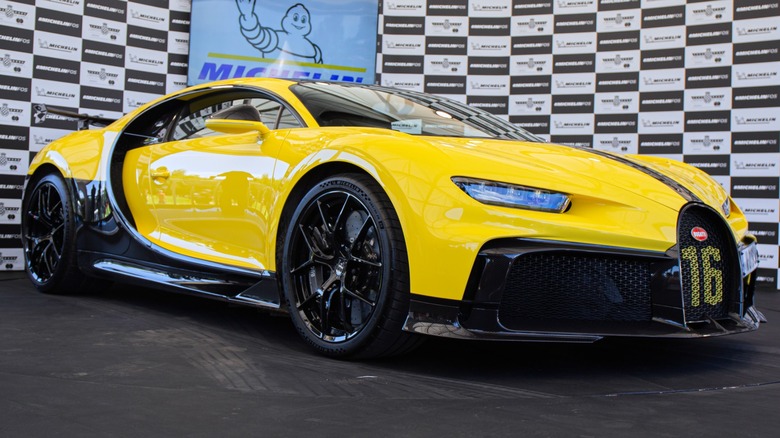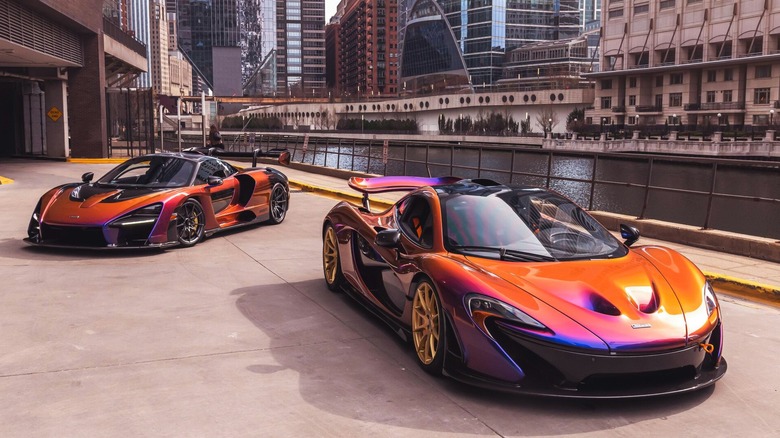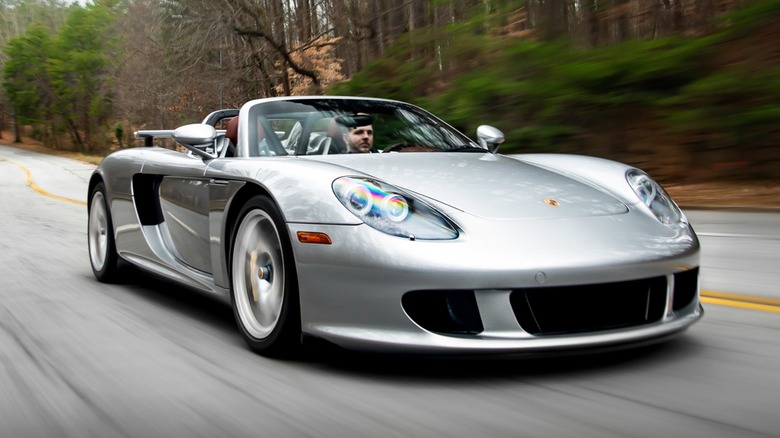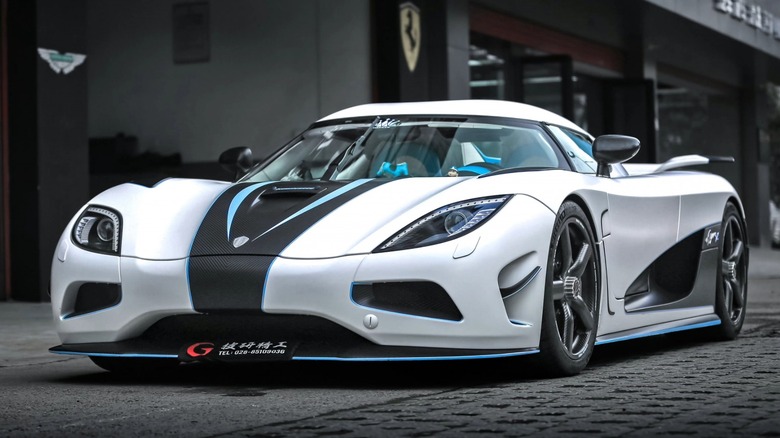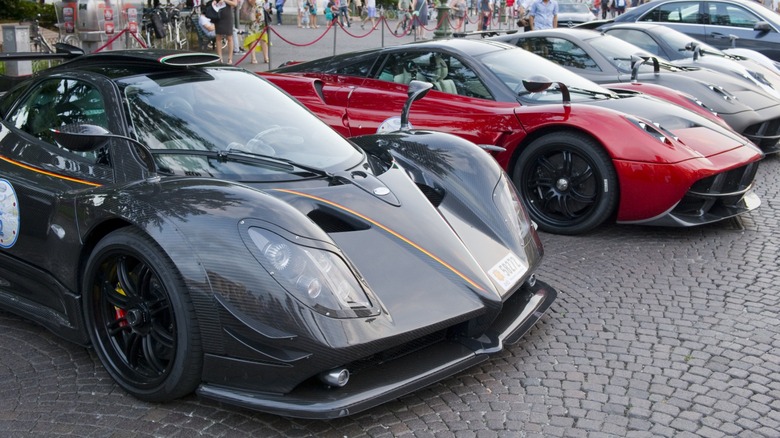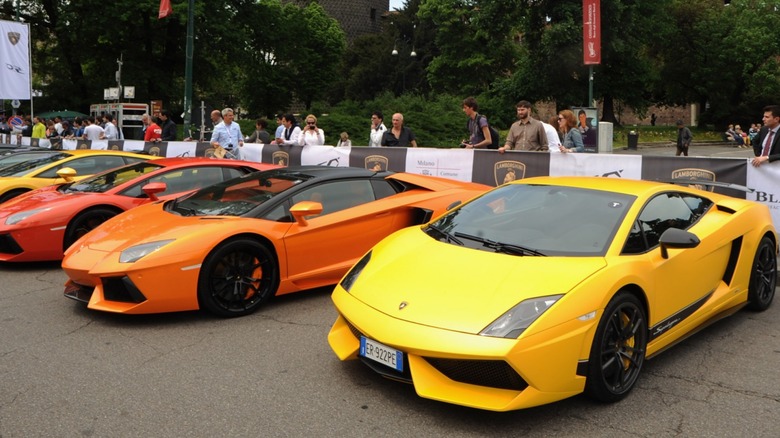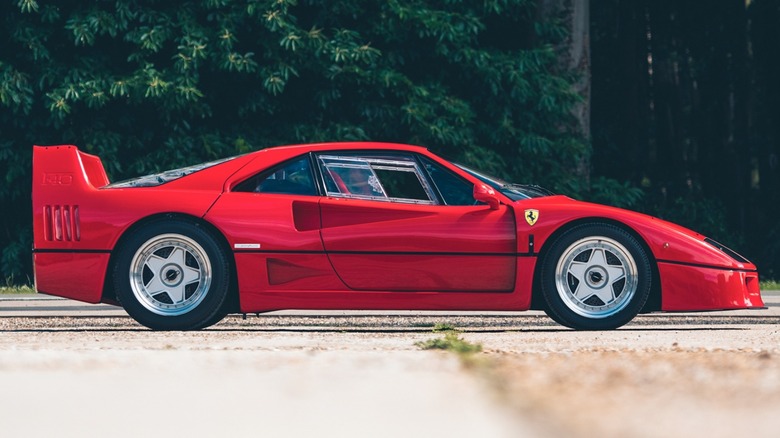Every Major Supercar Brand Ranked Worst To Best
Of all the cars built over the last century, those with the greatest potential for speed adorned by the most flamboyant style have always been the most desirable. Ever since Lamborghini introduced the world to the mid-engined wonder called the Miura, those desirable cars rising above all the others have come to be known as supercars. While there is no official automotive designation of supercar or well-defined criteria for proper classification, the cars that typically fall into the category share several traits. Typically, a modern supercar carries only two passengers, with a fluid and sporty design wrapped around a frame holding the engine in the middle, behind the seats. Historically, they have been rear-wheel-drive models, but advancements in engineering have led to the best-performing cars to spin all wheels simultaneously for solid traction. Other traits, such as powertrain and optional accessories, are more fungible, but supercars unanimously share one thing in common; a high price tag.
The best-known Italian supercars have almost exclusively come with V12 engines, but technology improvements over the years have allowed manufacturers to squeeze an inordinate amount of power from increasingly smaller engines. Supercars today come with a range of engines, and some of the newest use hybrid tech to raise horsepower levels to ludicrous new heights. Furthermore, we are now in the age of the electric supercar, which is also a signal of what is yet to come. Regardless, there exists a cross-section of the public that would like nothing more than to have the opportunity to own one of these cars, from any manufacturer. So here is a ranking of all the supercar manufacturers, from worst to best.
Maserati
The Maserati brothers established their company in 1914, just before war broke out across Europe, and car production itself began after the war ended. From the start, creating fast cars to win on the track was integral to the operation, and Maserati has been responsible for some of the most beautiful and elegant, but winning, race cars in history. Production in the post-war period resulted in a long list of grand touring cars featuring the height of Italian style, merged with cunning engineering and a smattering of luxury. However, none of the cars made could be considered a supercar, not even the mid-engined models of the '70s like the Merak, due to weak sub-200 horsepower engines.
The new millennium brought Maserati into the supercar business with its MC12 supercar of 2004 and 2005. What is essentially a race car made legal for the road came to be from the common ownership of Maserati and Ferrari, as the MC12 is all Ferrari Enzo underneath its flashy facade. Jeremy Clarkson reviewed one on Top Gear, and, although it was lightning-fast, he was not impressed. This has been followed up with the MC20 in 2020, with well-received updates. However, great as these cars may be and how amazing Maseratis of the past truly are, two models over as many decades do not make you much of a supercar brand, which places Maserati at the back of the pack.
Hennessey Special Vehicles
For more than 30 years, a Texas man named John Hennessey has been taking fast cars and raising power outputs to near-dangerous levels; as Hennessey even says (via Hennessey Performance), a truly powerful car should come with a "healthy dose of fear." Hennessey has been re-engineering drivetrains in popular sports cars of leading manufacturers for years. This has led to such creations as a 708-horsepower C8 Corvette and an 850-horsepower Mustang, both of which are available today. It has also led to the creation of its own supercars.
Hennessey first created the Venom GT in 2013. It is based on a Lotus Exige, but modified so much that its wheelbase and track are much larger than the Lotus. This was done to accommodate a 725-horsepower V8 in a car that typically carries a 4-cylinder or V6 with less than half the power. That was followed up with the Venom F5, an all-new, mid-engined supercar built from the ground up, with a bespoke V8 that produces a neck-breaking 1,817 horsepower and is capable of speeds upwards of 300 mph. Although Hennessey is only building 24 examples of this car, it does qualify as a supercar, making Hennessey a supercar brand. And, as utterly bonkers and endlessly appealing as the Venom F5 is, a production level of about 30 cars between the two makes it hard to rate Hennessey closer to the top.
Aston Martin
As an icon of British engineering and style, it is hard to do better than Aston Martin. The first car was completed in 1915, but the Great War interrupted production, which restarted in 1920. Racing commenced in 1922, continuing to be a part of Aston Martin from then on. For consumers, Aston models have mostly been grand tourers with superb refinement and a healthy degree of classic English luxury, including fine leathers and hand-crafted wood trim. The company is probably best known for its tie-in with the James Bond movie franchise, with the titular character more often than not driving a custom Aston Martin.
While Astons are well-known for powerful luxury cars, only recently has the company forayed into the world of supercars. Although Aston's supercar venture is new, the company is doing it right, releasing a couple of very exciting models. The first super Aston is the Valkyrie, a sculpted mid-engine machine that boasts a Cosworth 6.5-liter V12, combined with hybrid technology for a total power output of 1,139 horsepower. Its sculpted exterior also provides an amazing 2,425 pounds of downforce, ensuring the Valkyrie is about the most firmly planted car on the road. It is also $3 million, so buyers are limited to the ultra-wealthy. Following this car will be the Valhalla for 2024, which will have a Mercedes-AMG V8 with hybrid motors pushing upwards of 1,000 horsepower, for a retail price of around $800,000. Time will tell what kind of supercar brand Aston Martin will be, but with these two entries, it has entered the field.
SSC North America
Jerod Shelby created Shelby SuperCars, starting out by building one of the fastest cars in the world at the time, the Ultimate Aero, which sparred with the Bugatti Veyron in a tit-for-tat to claim the world's fastest car title. Somewhere along the way, some high-level talks convinced him to change the name to SSC North America, to prevent confusion with the other American Shelby in the auto business, the legendary Carroll Shelby, and the cars that bear his name. But that hasn't slowed Jerod Shelby down a bit.
The latest vehicle from SSC is called Tuatara, named for a New Zealand reptile. The body, chassis, and wheels are constructed entirely of carbon fiber, and power comes courtesy of a jointly developed Nelson Racing Engines V8 sitting in the middle. That engine is a 5.9-liter fed by twin turbos and is good for an astounding 1,750 horsepower. All of this is contained in a sleek and sexy package with styling to rival anything from the Old World. It also comes with a price tag approaching $2 million, so don't expect to see any on the commute home. SSC cars are hand-built and are in extremely limited production, making it another supercar brand for the extravagantly well-heeled. Perhaps when it expands into producing cars for those who are merely rich, it can move up the list.
Rimac
Finding a cutting-edge up-and-coming supercar star originating from Croatia might sound like the most unlikely of stories, but it is all true. Rimac Automobili is the brainchild of Bosnian-born Mate Rimac, who as an infant was relocated to Germany with his family as the Balkan Wars of the '90s were beginning, and later returned to settle in Zagreb, Croatia, where he developed an interest in cars. When his 1984 BMW 323i blew its engine, he endeavored to replace it with an electric drivetrain, but had to create one from scratch. The intrepid spirit continued until the company that bears his name released a Croatian-built supercar built with few outsourced parts or technology, even its switchgear.
The Nevera is Rimac's first production car, and it is a striking two-seater with an abundance of grunt in the way of 1,813 horsepower. The first production car was delivered to a customer in August of 2022, and it is motivated by an electric motor for each wheel, while its 117.0-kWh battery gives it a range of 205 miles. Inside the car, you will find a nicely appointed interior that is commensurate with what you might expect in a car with a price exceeding $2 million. The Nevera is a highly limited-production car, but the company has big plans on the horizon. Most impressive is that this extremely young company has merged with Bugatti, with Mate Rimac as its CEO. Rimac is bringing its now-proven EV tech to help Bugatti navigate the EV-powered supercar future, so expect good things to come from this interesting collaboration.
Mercedes-Benz AMG
Automaker Mercedes-Benz needs no introduction as its roots go back literally to the invention of the automobile. The automaker has been on the cutting edge of automotive innovation from the very beginning, and has been responsible for breakthrough technologies for more than a century. Although the company has long been involved in racing and manufacturing fast and powerful cars, supercars have never been part of its repertoire. But, like any evolving company, it can change.
AMG is the performance arm of the company, acting as an in-house tuner to tweak its regular production cars to create high-performance special editions, such as the SLS AMG and the AMG Hammer. But now, AMG has gone full hog and built an entire car, and it is magnificent. Called the AMG ONE, it is a mid-engined supercar showcasing the most extreme engineering possible to put in a road-legal automobile.
Like a regulation F1 race car, the AMG One features a 1.6-liter V6 with an 11,000 rpm redline, paired with electric motors to get the car to 60 mph in just 2.9 seconds. The list of high-tech features is so long it's obscene, but the exterior is an aggressive thing of beauty. Being equivalent to a race car will necessitate some significant sacrifices in luxury, but bragging rights come at no additional cost. These exclusive supercars are priced at $2.8 million, with a planned 275 units produced, and the first one has already been delivered. This officially puts Mercedes in the supercar business, but it will have to expand its offerings to raise its cache as a supercar brand.
Bugatti
The Bugatti marque has been synonymous with speed and elegance since its creation by Ettore Bugatti in the early 20th century. Part of the company's history is a penchant for breaking speed records, which the company accomplished first in 1904 at 120 km/h, and lastly in 2020 at 500 km/h with the nearly 2,000 horsepower Bolide. The later part of the company's timeline has been that of the premier maker of opulent supercars, beginning with the EB110 of the '90,s and running through to the Veyron of the 2000s, finishing off with the Chiron at the turn of the 2020s.
The modern Bugatti automaker is a division of the Volkswagen Group, its premier manufacturer of cars for the most discerning car buyers in the world. Those who have no limit in purchasing power, but desire the ultimate powerhouse of an automobile slathered in opulence, buy a Bugatti. The first model released under the VW umbrella in 2006 pushed boundaries toward excess, as it came with a 16-cylinder engine with four turbos and a power output exceeding 1,000 horsepower. Then, needing to build upon its predecessor, the Chiron followed the Veyron and upped the excess to 1,500 horsepower.
The final gasoline-powered Bugatti has been sold, but not yet built, and the cost was more than $3 million. However, Bugatti is going nowhere and is working on the Chiron successor with Rimac for a 2024 reveal, and it should prove to be the most excessive EV we've ever seen. If the past is a prologue, that is exactly what we should expect from the next Bugatti; plenty of excess.
McLaren
Bruce McLaren of New Zealand, founder of McLaren Automotive, was a force to be reckoned with as a driver in auto racing from the 1950s, increasing his stature by building winning cars made for the track until his untimely death in 1970. Continuing the founder's legacy as a company, McLaren solidified its legendary status when it released the F1 supercar in the '90s, creating a car against which all successive supercars will be judged. In terms of looks, technology, and driving experience, the F1 could be considered the perfect car. And it does not matter how much more advanced, technological, and powerful new supercars become, they will still be held up against the F1.
McLaren expanded its consumer car manufacturing footprint beyond a single model in 2011 to become a world-class supercar manufacturer, first with the MP4-12C, before further increasing the range of models on offer, including several exclusive special editions and ultra-high-end one-offs. McLaren's current range includes five models, including one plug-in hybrid with pricing starting above $200,000 and a horsepower range of 612 to 755. McLaren has experienced some teething issues in building this enterprise. It does not take long to find numerous reports of quality control issues and issues such as panel gaps that don't belong in cars that cost three times more than a loaded S-Class Mercedes. Still, McLaren has plenty of potential left, and the cars it makes benefit from years of racing development, so it is likely the best McLarens are still to come – except the F1, which is already the perfect car.
Porsche
Since its founding, Porsche has been laser-focused on building high-performance cars with clever engineering. The modern Porsche company began in the post-WWII period, with an emphasis from the start on building agile and lightweight cars with precision engineering that also happens to be comfortable and reliable, qualities absent in early sports cars. It quickly established itself as a preeminent maker of sports cars, and throughout its history has offered cars that offer extremely high performance with reasonable prices — at least relative to the exotic automakers it competes with. However, about once per decade, Porsche releases a special ultra-high-performance model that can compete with the best of any supercar.
The earliest of what could be considered Porsche supercars include the 1960s 904 Carrera GTS or the 911 Turbo a decade later, but the 1986 Porsche 959 raised the bar for all high-performance cars for many years to come. It was way ahead of its time by being the first performance car with electronically controlled suspension and a tire pressure monitoring system, along with sophisticated engineering throughout the rest of the car. It was groundbreaking, and Porsche continued this tradition with its 911 GT1 in the '90s, the Carrera GT in the 2000s, and the 918 Spyder more recently in the 2010s. All of these are incredible cars that are also incredibly fast, and are now highly valuable collector's items. Porsche is due for another supercar, so we shall see what comes next from Stuttgart in the next few years. Regardless, Porsche shall remain among the top supercar makers for some time.
Koenigsegg
Headquartered in Ängelholm, Sweden, Koenigsegg manufactures sleek and modern supercars that employ the most innovative and creative engineering of any automaker today. Furthermore, for a company with barely 20 years of history under its belt, it has exceeded the expectations of a fledgling supercar maker to become a world-class manufacturer that competes with the best of them.
The first production Koenigsegg arrived in 2002 with the CC8S. The first models created by Koenigsegg utilized Ford's Modular 4.6-liter V8 engines, but with extensive modifications that increased output up to 655 horsepower. They also introduced the mesmerizing Koenigsegg signature dihedral synchro-helix doors, which allow the doors to rotate upwards and outwards in a seamless and fluid motion. By 2011, cars were equipped with turbocharged V8 engines designed in-house that are built to run on regular pump gas or E85, and can push the cars close to 300 mph. Its most recent models now come with a power output of up to 1,600 horsepower and the fastest-shifting transmissions in the world.
Koenigsegg is a very low-volume manufacturer, making only a few cars per year for those who can afford to spend more than $2 million on what it dubs "hypercars." Furthermore, the engineering and technology coming from the company are at the bleeding edge of mechanical development, including its proprietary Freevalve tech that operates valves without a camshaft, and its "Tiny Friendly Giant" 3-cylinder engine that produces in excess of 600 horsepower. Clearly, Koenigsegg is among the best supercar makers in the world, and only if its cars were more accessible would it move up in its ranking.
Pagani
Few people have the grit and determination of Horacio Pagani, who created and built several automotive products in his home in Argentina and then moved to Italy determined to work for Lamborghini, taking a job doing unskilled labor just to get his foot in the door. He eventually rose to a lead design position, before leaving to strike out on his own. That led to the founding of Pagani Automobili, manufacturer of the finest automotive works of art in the world.
The first car produced by Pagani, the Zonda, debuted at the Geneva Motor Show in 1999, impressing everyone who saw it with its stunning good looks and attention to detail. AMG provided 7.0-liter V12 engines specifically tuned for Pagani that produce 540 horsepower, which was especially impressive for 1999. But even if the Zonda was powered by a moped, the gorgeous and curvaceous styling would make up for it entirely. Pagani's second car was the Huayra in 2012, this time with a twin-turbo 6.0-liter V12 from AMG, good for 730 horsepower. Other cars may have more power, but Paganis use it effectively with lightweight materials and minimal drag. Inside, you will find lavish interiors filled with premium materials and interior design just as exquisite as the exterior, which is to say they are beautiful in every way.
Unsurprisingly, these cars are costly, with the first Zonda priced at $280,000 and successive models quickly rising into the millions, such as the Pagani Zonda HP Barchetta, which sold for $17.5 million. A new model, the Utopia, is on the way, which will further cement Pagani in the top tier of supercar makers.
Lamborghini
Born out of a spat arising between hot-headed Italian industrialists, the company that bears Ferruccio Lamborghini's name became known as the manufacturer that builds the wildest and fastest cars on the planet. Furthermore, Lamborghini practically invented the supercar with its Miura in 1967. Ever since, the automaker has been known for producing brash, loud, and fast cars that have become Italian automotive icons, as well as objects of desire the world over.
Lamborghini is currently a division of VW. But before VW took ownership, the automaker was mostly a boutique manufacturer building a limited number of cars every year. The legendary Countach broke boundaries with its aggressive styling and lasted 19 years in production from its first prototype, with a total of about 2,000 cars built. Its successor, the Diablo, increased the pace with 2,903 built from 1990 to 2001.
Throughout its history, Lamborghini has been the standard bearer for beautiful but garish supercars that are powerful, fast, and very expensive. Lamborghinis have an unmistakable style recognized throughout the planet, and are a mainstay in the supercar world, with classic and modern examples dominating car shows, auctions, and race tracks alike. It is easy to say Lamborghini is among the best of the best.
Ferrari
Italian automaker Ferrari, known for its prancing horse logo, is possibly the most recognized maker of sports cars in the world. Founded by Enzo Ferrari, the company originally built cars for sale to raise funds for his racing team, Scuderia Ferrari. The cars proved to be incredibly popular, and the success of his Colombo V12 engine, which stayed in production from 1947 to 1989, paved the way for Ferrari automobiles to become the finest sports cars in the world.
Early Ferrari models were mostly roadsters that were followed by several grand touring cars through to the '60s. Yet, when Lamborghini released the Miura, Ferrari had to respond quickly. In 1968, Ferrari manufactured a mid-engine car, but it had a modestly powered V6 – only 180 horsepower — and was sold under the Dino brand. But in 1973, the Berlinetta Boxer arrived with a 380-horsepower flat-12 engine behind the seats, beginning a long line of excellent Ferrari supercars. This would be followed by legends such as the Testarossa, F40, F50, Enzo, LaFerrari, and, currently, the SF90 Stradale.
Ferrari has made a wide range of superb and finely crafted machines for decades now, including some that have become among the most valuable cars in the world — a 1962 Ferrari 250 GTO sold in 2018 for $48 million. Furthermore, its supercars are of the highest caliber, performing at levels that test the limits of physics itself. All the while, Ferrari has maintained styling and design that make its cars immensely appealing with a blend of classic lines and modern sophistication. Quite simply, there is no car in the world quite like a Ferrari.
